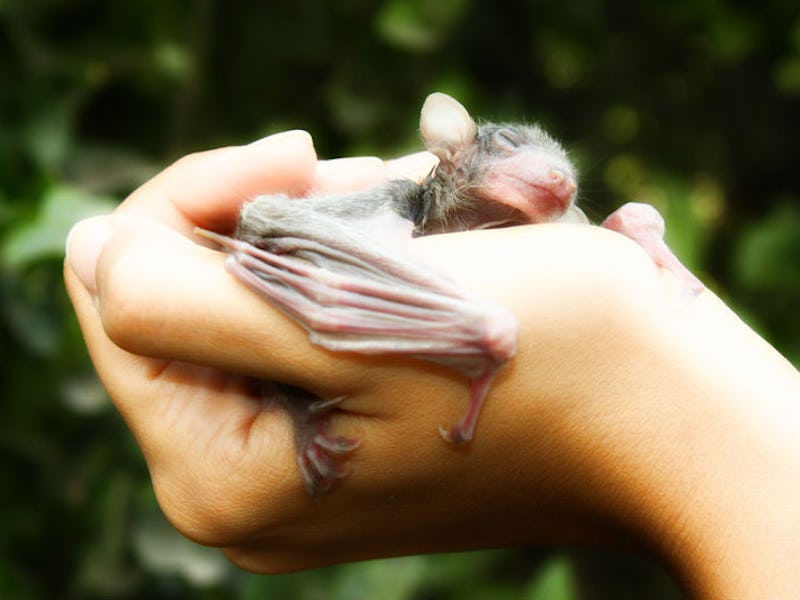Fruit Bats' Brain Activity Literally Syncs Up When They Socialize
These bats might as well finish each other's sentences.

When you grow close to someone, it can feel like you’re on the same wavelength. You might even finish each other’s … sentences! It’s not just a feeling, though. Research on humans has shown that this phenomenon has measurable physical properties, both in the brain and the autonomic nervous system. Now, work published in the journal Cell shows that a species of bats also exhibits neural synchronization while engaged in social activities like grooming, sniffing, and even fighting.
In a paper published on Thursday, a pair of researchers at the University of California, Berkeley measured the brainwaves of Egyptian fruit bats (Rousettus aegyptiacus) during natural social interactions. They observed that pairs of bats showed nearly identical brain wave patterns while they were interacting, for times ranging anywhere from seconds to hours.
Wujie Zhang, Ph.D., a postdoctoral scholar in The NeuroBat Lab at UC Berkeley and the first author on the paper, tells Inverse that the bats in his team’s lab may actually be behaving in a way that’s very similar to the way humans do, at least on a neural level.
“The results suggest that similar neural processes are behind social interactions by humans and non-human mammals,” he says. “In other words, at the neural level, social interactions by non-human mammals are perhaps qualitatively similar to human social interactions.”
Egyptian fruit bats live in close communities, so the researchers used them to examine the neurological markers of social behavior.
Zhang worked with Michael Yartsev, Ph.D., the principal investigator of the lab. They surgically equipped four male bats with tetrode microdrives, tiny devices used to wirelessly record the activity of multiple neurons at the same time. The advantage of this approach is that it allowed the bats to fly around and generally behave naturally — as opposed to in an fMRI machine, where they must remain still to give an accurate reading.
Zhang and Yartsev put the bats through many rounds of observations, including some in separate but adjacent chambers, and some in the same chamber.
When the bats were in separate chambers, they could see each other through the clear walls. But in these situations, their brain wave frequencies didn’t really match up at all.
Once the researchers put them in the same chamber, their brain waves reached a higher level of correlation, but they still didn’t match — even when the bats were doing similar behaviors, like grooming themselves.
The more closely the bats interacted, the more similar their brain activity became.
After the bats began interacting, though, the correlation between their brain waves was notable, and it correlated with their level of interaction.
“We found that on sessions where the bats interacted with each other more, the neural correlation across their brains was higher, and on sessions where the bats interacted less, the neural correlations were lower,” Zhang and Yartsev write. Even when a third bat was added to the mix, often resulting in a scuffle with one of the neural implant bats, the bystander still showed similar activity as its companion who fought the newcomer.
As the bats groomed each other, sniffed each other, and occasionally fought, their brains showed similar neural activity, in much the same way that humans’ nervous systems do. Zhang says this suggests that the same evolutionary process may be responsible for human brain synchronization and bat brain synchronization.
“Our findings put the neural underpinnings of human social interactions in an evolutionary context,” he says. He also notes that this isn’t some kind of magical link, but rather a feedback system.
“Two brains only interact indirectly, through the social interaction behaviors between two individuals,” he says.
Research on this type of neural correlation suggests that as one individual interacts with another, their brain focuses on the other’s behavior, making their own behavior and neural activity reflect that other’s behavior. This creates a closed feedback loop, in which the activity in each individual’s brain starts to resemble the other more and more.
Zhang says their next steps will be to figure out how this synchronization happens. To do this, he’ll look at specific brain areas associated with the bats’ social interactions.
Abstract: Social interactions occur between multiple individuals, but what is the detailed relationship between the neural dynamics across their brains? To address this question across timescales and levels of neural activity, we used wireless electrophysiology to simultaneously record from pairs of bats engaged in a wide range of natural social interactions. We found that neural activity was remarkably correlated between their brains over timescales from seconds to hours. The correlation depended on a shared social environment and was most prominent in high frequency local field potentials (>30 Hz) and local spiking activity. Furthermore, the degree of neural correlation covaried with the extent of social interactions, and an increase in correlation preceded their initiation. These results show that inter-brain neural correlation is an inherent feature of natural social interactions, reveal the domain of neural activity where it is most prominent, and provide a foundation for studying its functional role in social behaviors.